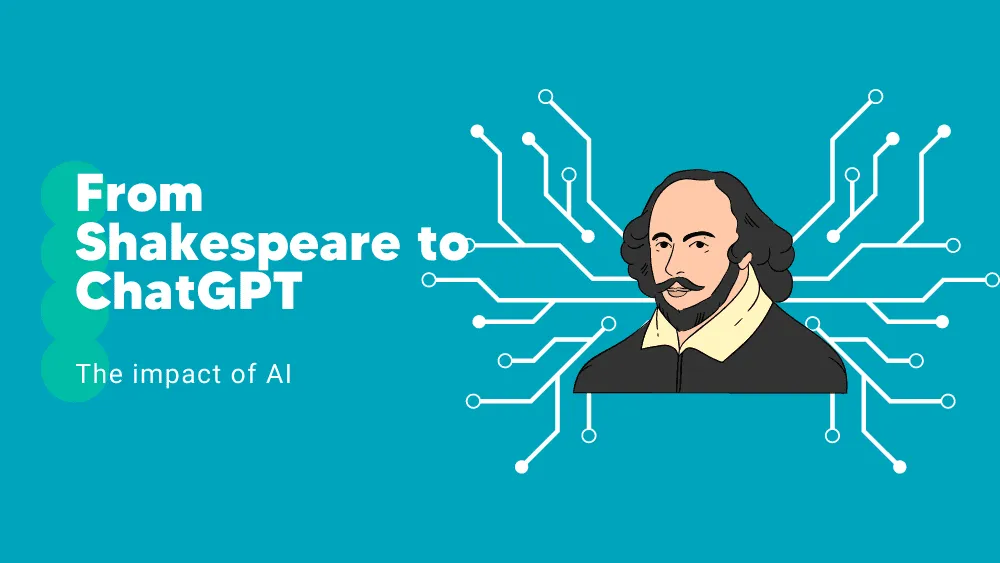Table of Contents
Let’s face it; AI is as much a part of today’s business environment as coffee is a part of your morning routine. It’s an instrument changing how businesses operate, decisions, and even the creative process works. It’s the secret behind that Netflix recommendation that was spot-on, the way your spam folder miraculously keeps junk out of sight, the power behind self-driving cars, and that one guy in the office who can write ten not-so-good articles daily. It’s what’s helping companies stay ahead of the curve, making smarter, faster, more informed decisions than ever before – if it’s used right.
AI and its potential are not as straightforward as some think – it will not simply take out jobs overnight. It remains shrouded in a cloud of intrigue, often misunderstood and misinterpreted. In this article, we’ll pull back that curtain or try to shed some light on this complicated phenomenon.
We’ll try to simplify the complex algorithms, make sense of machine learning, and decode deep learning. Whether you’re a seasoned CEO, an innovative entrepreneur, or a business enthusiast hungry for knowledge, this guide is for you.
Understanding Artificial Intelligence
Artificial Intelligence is an exciting offshoot of computer science designed to create systems that can take on tasks that traditionally require human intelligence. Be it understanding spoken language, recognizing patterns, learning from experience, or making decisions.
This self-improvement process, achieved without any new programming instructions, is the domain of ‘machine learning.’ It’s the art of learning from patterns in data, improving over time, and doing so without the necessity of direct human intervention.
A common term associated with AI is ‘neural networks.’ These networks are designed to mirror the human brain’s interconnected information-processing system. Each node or “artificial neuron” takes in data, performs its calculations, and passes the information onward. When these nodes collaborate, they can decipher complex patterns in data.
Then there’s ‘B,’ an advanced form of machine learning, where the neural networks are deep, meaning they have more layers. This added depth allows deep learning to grapple with more complex tasks, from recognizing faces in a crowd to understanding requests for weather updates.
The Different Types of Artificial Intelligence
Narrow AI
Narrow AI is also known as weak AI but don’t be fooled by the name. Narrow AI is highly specialized and designed to perform a specific task. This can be anything from recommending a song on Spotify to translating a foreign language text in real time. The AI systems that we interact with daily, such as ChatGPT, Bard, Midjourney, and many others, are examples of Narrow AI. These systems excel in their duties but ask them to do something out of their realm (or draw hands), and they’re as lost as a penguin in a desert.
Narrow AI has a significant place in the business world, aiding everything from customer service to data analysis. It automates routine tasks, assists in decision-making, and enhances productivity. It’s the type of AI that we will be talking about, mainly because the other one is still dreamt of.
General AI
This form of artificial intelligence remains largely hypothetical but is a driving force behind many research efforts. It is (or at least it should be) designed to understand, learn, and apply knowledge across a wide range of tasks, just like a human would, a smart one.
The implications of General AI are profound and far-reaching. It promises a future where AI can adapt to new situations, solve unfamiliar problems, and self-improve in ways currently limited to humans. The potential applications are limitless and thrilling, from driving research in medical science to managing complex supply chains. However, it’s essential to remember that General AI is still in the realm of science fiction and a subject of intense research and debate.
Practical Applications of AI in Business
After all that theory, it’s time to get down to business, quite literally. The exciting world of SaaS is where AI shines, adding a bit of pizzazz to a concept and seemingly empty words.
Customer Service
- AI Chatbots: These diligent digital workers are transforming customer service as we know it. No more waiting for office hours to have queries answered. Chatbots operate round-the-clock, providing prompt, accurate responses and instant support.
Examples: Ultimate, Intercom
- Predictive Analytics: By examining customer behavior and anticipating needs based on data patterns, AI-enabled predictive analytics tools provide businesses with the power to not just react but proactively shape the customer experience, thereby ensuring satisfaction and loyalty.
Examples: RapidMiner, Insider
Marketing and Sales
- Lead Scoring and Predictive Sales Analytics: AI algorithms assess potential customers’ data to score them based on their likelihood to convert. They also analyze past sales data to forecast future trends.
Examples: Outfunnel, Mediafly Intelligence360
- Personalized Marketing Campaigns: AI can craft highly personalized marketing campaigns that resonate with individual customers, thereby enhancing customer engagement and boosting campaign success rates.
Examples: Mailjet
- Content Marketing: AI-enabled tools leverage machine learning to generate, proofread, and optimize content according to the user’s preferences.
- Designing: AI also has a role to play in the visually creative world. AI-powered tools provide designers more time to brainstorm and execute groundbreaking ideas, from creating logo designs to developing aesthetically pleasing images.
Examples: Midjourney, DALL·E 2
Operations and Productivity
- AI-powered Tools: AI takes over the monotonous tasks that can sap productivity, such as data entry, scheduling, and basic administrative duties. This ensures that the human workforce can focus on more strategic, creative value-added activities.
Examples: UiPath, Automation Anywhere
- Predictive Analytics: It analyzes past operations data to identify inefficiencies and predict future needs or potential roadblocks, optimizing resource allocation and workflows.
Examples: IBM’s Watson, TIBCO
Business Intelligence and Analytics
- AI Tools for Big Data: Extracting insights from massive amounts of data can be daunting, but with its ability to identify patterns and correlations, AI simplifies big data analysis, helping businesses derive meaningful, actionable insights.
Examples: Tableau, Microsoft Power BI
- Real-time Business Intelligence: AI allows businesses to process and present data in real time, enabling swift responses to market changes.
Examples: Sisense, Looker
Challenges and Disadvantages of Artificial Intelligence
The advantages of incorporating intelligent systems are significant, yet it’s not an entirely frictionless journey. Some challenges and potential downsides must be acknowledged and addressed. Understanding these obstacles can shape effective mitigation strategies and guide successful implementation.
Data Privacy and Security
The core of intelligent systems lies in data. These systems feed off vast amounts of it, which raises essential questions about privacy and security. While they can improve security measures by predicting and detecting potential threats, they also paint a large target on organizations for cyberattacks. The responsibility of handling and protecting this data is substantial, and breaches can lead to damaging consequences, both reputationally and financially.
Ethical Considerations and Job Displacement
The societal and ethical impact of intelligent systems is profound. As automation increases, fears around job displacement escalate. The concern that systems might replace human roles, leading to job losses and increased unemployment, is contentious. Striking a balance between leveraging the benefits of automation and maintaining a human-centric approach to work is a delicate and ongoing challenge.
Complexity of Implementation
Deploying intelligent systems isn’t as straightforward as flipping a switch. It involves deep technical know-how, comprehensive planning, and in many cases, a significant financial investment. It’s a complex process that demands careful integration into existing workflows, which can be daunting and require a significant time commitment. Overcoming this obstacle often means developing or acquiring the right technical expertise.
Risk of False Positives/Negatives and everything else
Accuracy is a crucial component of intelligent systems, yet they’re not infallible. Occasionally, these systems may produce false or misleading results, leading to decision-making and strategic planning inaccuracies. Businesses must ensure they have mechanisms to verify and cross-check results to avoid taking action based on misleading information.
Decision-Making Guide: Should Your Business Adopt AI?
Transitioning to artificially intelligent systems is like switching to a new coffee blend – a decision that could improve daily operations or leave a bitter taste. Here’s a little guide to help you with that.
Evaluating Business Requirements for Intelligent Systems
Before the decision to adopt artificial intelligence is made, conducting a detailed examination of the business environment is crucial. Areas currently struggling, such as data management, customer service, or task automation, may benefit from the introduction of intelligent systems. This assessment will identify the business aspects that AI solutions can potentially improve.
Choosing the Right AI Solution
The specific needs of a business should dictate the choice of an AI solution. Different AI systems have various specializations – some are proficient in automating tasks, others in enhancing customer service, and some excel in data analytics. Recognizing these distinctions can help select the system that aligns with the company’s identified needs.
Consultation with Experts
Expert advice can be invaluable during the decision-making process. By consulting AI specialists or vendors, businesses can gain industry insights, obtain personalized solution recommendations, and be guided away from potential missteps. This assistance can help to streamline the selection process and ensure the most effective solution is chosen.
Budgeting and Planning for AI Integration
The introduction of artificial intelligence into a business involves a significant investment. It’s not just the financial aspect to consider; time, resources, and employee training also play crucial roles. A meticulously devised budget and carefully planned timeline can help manage these commitments and prevent unforeseen challenges during the integration process.
AI’s Future in Business: Trends and Predictions
The future of artificial intelligence is as enticing and enigmatic as a mystery novel – and we’re all on the edge of our seats waiting to see what’s next. Taking a deep dive into expert predictions, here’s a distilled version of what Nir Kaldero, chief AI officer at NEORIS, envisages as published by Forbes Technology Council.
Data Consolidation and Full AI Deployment: Companies transitioning from AI pilots to large-scale implementations are predicted to reap significant benefits. This transition will include consolidating their data into multi-cloud and hybrid cloud environments.
Increased Cloud Use and Open-Source Services: Cloud services will continue to grow, with open-source technology services becoming increasingly integrated into companies’ cloud environments. This is partly due to the cost of cloud consumption as AI models scale up.
Expanded MLOps Skill Sets: The industry will require more skills in model deployment as it moves towards a focus on MLOps (Machine Learning Operations) at scale. This shift in skill requirements will be essential to prevent employment bottlenecks.
Data-Driven Decision-Making Becomes Essential: Being data-driven will no longer be optional but integral to business operations. This shift towards continuous data analysis and insight generation will foster better business decision-making and potentially improve work-life balance.
AI’s Role in Web3 and the Digital Metaverse: AI is set to play a pivotal role in the emerging digital metaverse. It will utilize data from various IoT devices to generate real-time recommendations, enhancing consumer experiences in the digital world.
Conclusion
Artificial Intelligence holds immense potential, capable of transforming businesses by automating tasks, enhancing services, and driving analytics. Yet, adopting this technology isn’t without challenges, including data privacy, ethical concerns, implementation complexities, and the risk of inaccuracies. Businesses must stay informed and adaptable, navigating these obstacles with strategic planning and deployment.
A robust understanding of AI is essential as we move towards a future where data consolidation, increased cloud use, and the growing digital metaverse become the norm. Businesses willing to adapt to these evolving trends will stay competitive and successful. Like switching to a new coffee blend, transitioning to an AI-infused business may require adjustment, but the results are promising, leading to increased efficiency and innovation.






